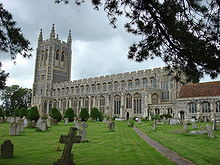Le Magnifique and Wool church: Difference between pages
←Blanked the page |
m add history (will add more later) |
||
| Line 1: | Line 1: | ||
[[Image:Long Melford Holy Trinity Church 01.jpg|thumb|Holy Trinity Church, Long Melford, Suffolk, a classic wool church]] |
|||
A '''wool church''' is an [[England|English]] [[Church (building)|church]] built primarily from the proceeds of the [[Middle Ages|mediaeval]] [[wool]] trade. Wool churches are common in the [[Cotswolds]] and [[East Anglia]], where enormous profits from the wool business spurred construction of ever-grander edifices. |
|||
The church at [[Long Melford]], Suffolk, is widely regarded as one of the finest wool churches in England. Built larely from 1467-to-1497, Holy Trinity contains magnificent stained glass from the fifteenth century, the Clopton family chantry chapel and the extraordinary Lady Chapel, which extends at the Holy Trinity's east end.<ref>[http://www.suffolkchurches.co.uk/Longmelford.htm Holy Trinity Church, Long Melford, Suffolk, suffolkchurches.co.uk]</ref> The [[Flushwork]] employed by the builders of Holy Trinity is some of the finest in England. The church stands as testimony to the wool business and its dizzying success in medieval times.<ref>[http://www.stedmundsbury.anglican.org/longmelford/ web site of Holy Trinity, Church, Long Melford, Suffolk]</ref> |
|||
Another grand Suffolk wool church is St. Edmund in [[Southwold]], which boasts extraordinary chancel screens.<ref>[http://www.suffolkchurches.co.uk/Southwold.htm St. Edmund, Southwold, photos, suffolkchurches.co.uk]</ref> (Although nearly all the medieval stained glass is gone, thanks to zealous Puritans during Cromwell's reign.) Ironically, Peter Hobart, who served as an assistant vicar of St. Edmunds following his graduation from [[Magdalen College, Cambridge]], later left Suffolk for the [[Massachusetts Bay Colony]], where Hobart would become the first pastor of [[Old Ship Church]] in [[Hingham, Massachusetts]], the oldest church in continuous use in the United States. |
|||
==References== |
|||
{{reflist}} |
|||
[[Category:Churches in Gloucestershire]] |
|||
{{gloucestershire-struct-stub}} |
|||
{{UK-church-stub}} |
|||
Revision as of 20:10, 10 October 2008

A wool church is an English church built primarily from the proceeds of the mediaeval wool trade. Wool churches are common in the Cotswolds and East Anglia, where enormous profits from the wool business spurred construction of ever-grander edifices.
The church at Long Melford, Suffolk, is widely regarded as one of the finest wool churches in England. Built larely from 1467-to-1497, Holy Trinity contains magnificent stained glass from the fifteenth century, the Clopton family chantry chapel and the extraordinary Lady Chapel, which extends at the Holy Trinity's east end.[1] The Flushwork employed by the builders of Holy Trinity is some of the finest in England. The church stands as testimony to the wool business and its dizzying success in medieval times.[2]
Another grand Suffolk wool church is St. Edmund in Southwold, which boasts extraordinary chancel screens.[3] (Although nearly all the medieval stained glass is gone, thanks to zealous Puritans during Cromwell's reign.) Ironically, Peter Hobart, who served as an assistant vicar of St. Edmunds following his graduation from Magdalen College, Cambridge, later left Suffolk for the Massachusetts Bay Colony, where Hobart would become the first pastor of Old Ship Church in Hingham, Massachusetts, the oldest church in continuous use in the United States.
References
